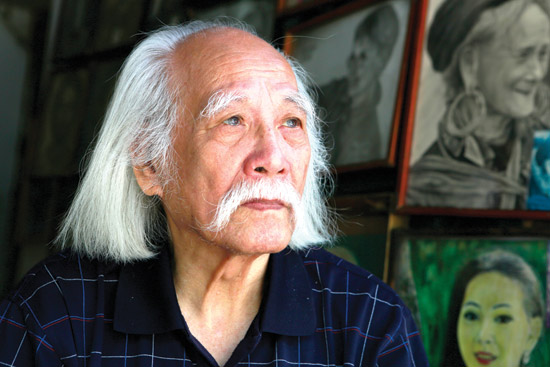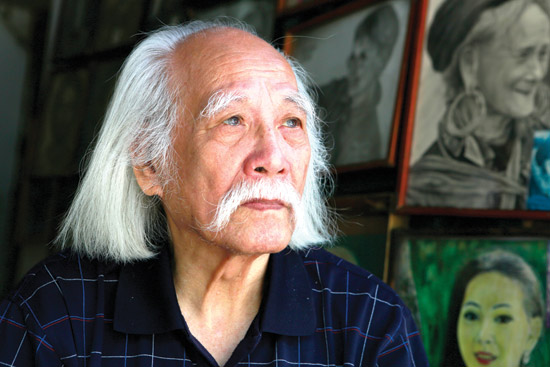(No.3, Vol.3, Apr 2013 Vietnam Heritage Magazine)
Ton Duc Luong artist.
Photo: Hong Vinh
Secretary of the era’, who ‘captured the humanity of his country’… these are some of the phrases the Vietnamese and foreign art fellows use to describe Mr Ton Duc Luong, an artist for Tien Phong newspaper. At 87, he suddenly became known internationally, due to hundreds of sketches on the themes of youth during the years 1960-1970. An exhibition of Mr Ton Duc Luong’s works was held in November, 2012 at the Vietnam Fine Arts Museum, organized by a Thai art collector.
One cannot describe Ton Duc Luong as a hermit, but perhaps because he didn’t talk much, many thriling details of his life have surfaced only recently.
Ton Duc Luong’s works came back to life due to a scrap collector. Once, the artist Mai Van Nam borrowed a number of Ton Duc Luong’s small size sketches to ‘market’ at the Vietnam Fine Arts Museum, together with works of many other artists. It is unknown if the museum bought any of them, but when Mr Luong asked for his paintings, Mr Nam said he couldn’t remember where he put them. When he died (1987), his wife sold them to a scrap collector, Mr Luong related.
The scrap collecting woman lived next door to Mr Thong, who collected art works to sell abroad. Thong saw and bought the bunch of Ton Duc Luong’s works and sold them to Tira Vanichtheeranot, a Thai art collector.
In an art exhibition of 29 Vietnamese artists organized by Mr Tira in Thailand, the National Heritage Commission of Singapore bought a few works by Ton Duc Luong. Perhaps that was why the Thai collector came to see Ton Duc Luong in 2008. On Mr Tira’s request, Mr Luong pulled down dust covered piles of paintings left on top of the wardrobe. Termites had been at them. ‘I sold them cheap, because the paintings have holes in ‘em, thought no much value’, the artist said. Mr Tira announced immediately: ‘I will print a book and exhibit these paintings for you in Hanoi and Saigon, and will also make a tour around Southeast Asia.’
Now the termite ‘colleagues’ became dear to Mr Luong’s heart: ‘That’s what added the value to it! The paper is rotten and yellow, termite eaten. Truly, [it is] authentic art!’
Besides the sketches, Ton Duc Luong had also some oil and silk, only about 20 pieces. Most of these have been sold to museums or foreigners. Some talked about the 70.000 US$ in 2010 that he received for his oil painting ‘Path Opening’.

Volunteers at work in Ha Tinh Province, Central Vietnam, 1970.
A sketch by Ton Duc Luong.
Photo: Hong Vinh
When coming for Ton Duc Luong’s sketches, Mr Tira brought with him 5 Thai artists. These artists couldn’t figure out what tool Mr Luong used to paint. It was neither paint brush nor stick. The strokes were thick and thin, strong and soft.
It turns out it was his Waterman pen. He bent the tip of the nib, so he could regulate the thickness of his line by the way he held the pen. If the nib’s hole touched the paper, he could even spread ink on a large area.
‘That’s the trick. Maturing it, I sketched very quickly,’ the artist said proudly. ‘None of these took me more than 15 minutes’. Asked why stop painting, he blamed his age, that it killed his inspration.
At his time, to be admitted to the Indochina College of Arts [in Hanoi], one had to pass at least a preparation year. Ton Duc Luong passed not a single day. Not knowing how to handle oil or water colours, he used only pencils.
While others usually mix colour with a kind of gel to make it stick to the paper, Luong mixed it with water to paint. So the colours on his border ornamental design in rose motive, submitted for the entrance exam were fresh, with cracks, which created a lot of ‘visual effects’. This design got the maximal grade of 20 –extremly rare in the history of the Indochina College of Arts.
Three months later he found himself among 15 admitted candidates. Luong asked his professor, artist Nam Son, why, if in the previous years only 10 cadidates were taken each year, why there were 15 that year. Mr Son said: ‘It’s because of you! Your other grades were just average, but your ornament design is the best of all times. Your total grade was ranked the 15th. The professors and I didn’t want to waste you, so we had to take 15.’
Nam Son was Ton Duc Luong’s only teacher in the time he studied at the college-over a year. In 1945, the school was closed, and Luong joined the Viet Minh to engrave metal plates to print portraits of President Ho Chi Minh with the national anthem.
In 1948, Ton Duc Luong moved to the Central Committee of Communist Youth to illustrate for newspapers Xung Phong, S?c Tr?, and lastly, the Ti?n Phong. The technology available then allowed printing art works only. Ton Duc Luong made hundreds of wood engravings to illustrate the news, until Hanoi was liberated in October, 1954. Of course after the newspaper was out, Luong’s engravings were thrown away.
Ton Duc Luong went everywhere by bicycle, from the North-West to the mid-Vietnam. He often chose to work on the theme of youth. He left about 500 sketches to exhibit yearly to support his coleagues’ morale. On his return in 1980, Luong asked about his paintings, only to learn that they were put on shows only 3 times, then became termite food. The 100 plus ones that survived are the ones with which he was not quite satisfied.
The collection on Hanoi and Hai Phong volunteer youth building roads in Nghe An, Ha Tinh, which brought him prize A in the Hanoi Art Exhibition 1967, silently disappeared. With no space at home, he kept them in a drawer in the office. While he was away on his trips, the office was some how tidied up, and his table was gone.
Ton Duc Luong made a lot of sketches, but not so many big pieces. It was simply because of lack of space at home. It took him five years (1970-1975) to finish the oil painting ‘Path Opening’ just because he had to pull it out, then put away all the time. Right now, he still lives with his eldest son’s family in the same apartment. Although it is on the Lake Shore, there is almost no natural light inside. That’s why the artist always feels that his paintings are cold: ‘Only outside I can realize that they are very warm, yellow all over.’

